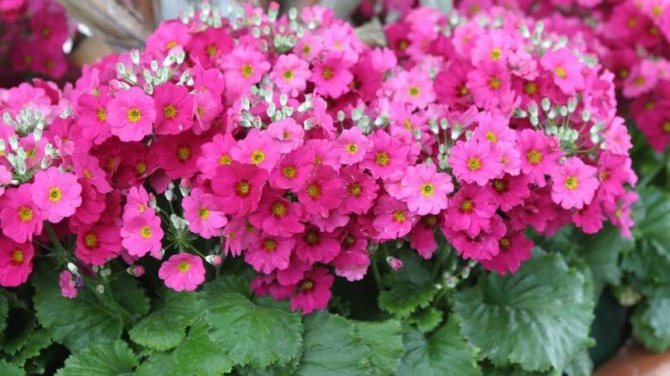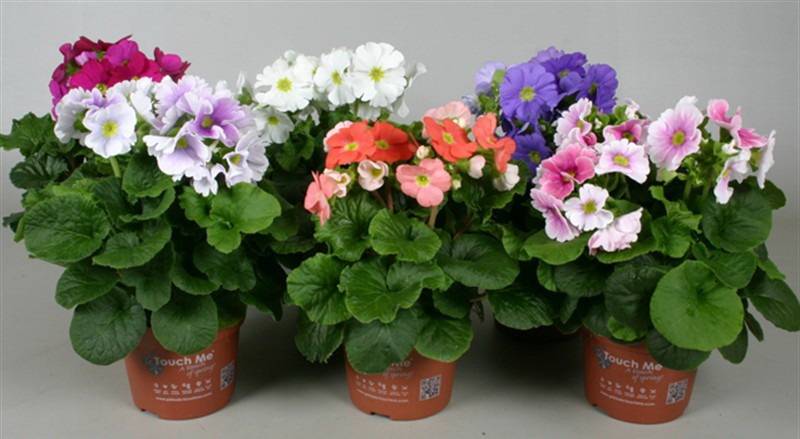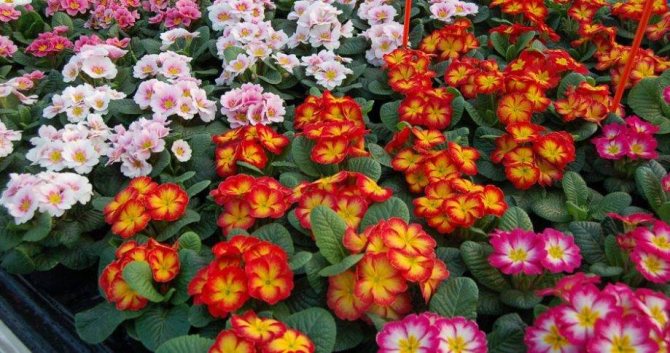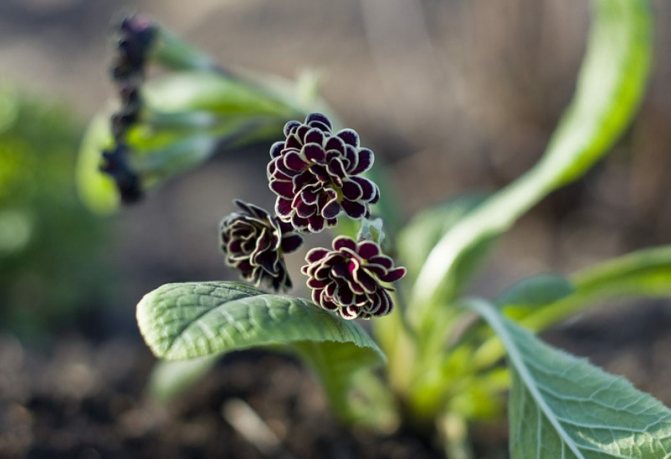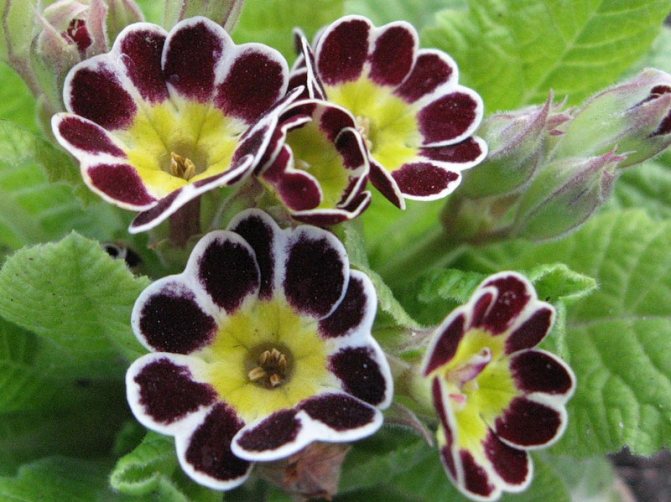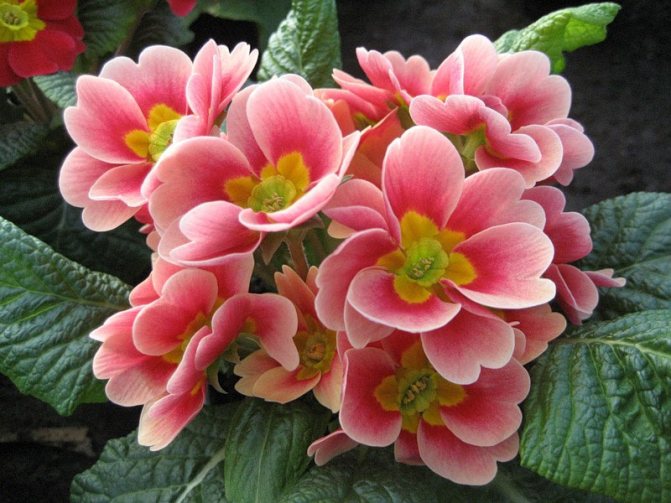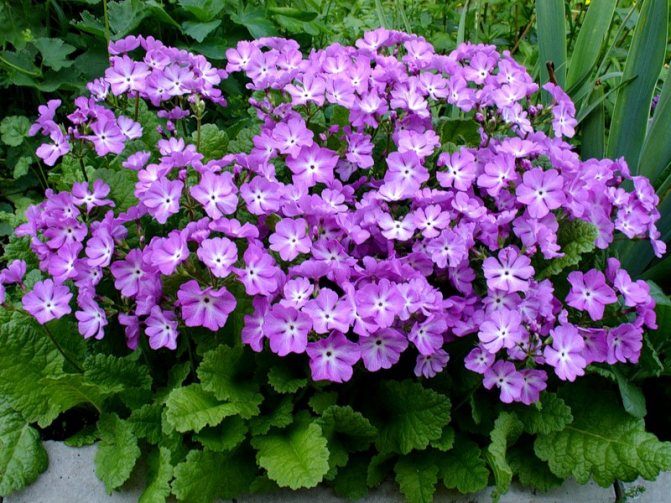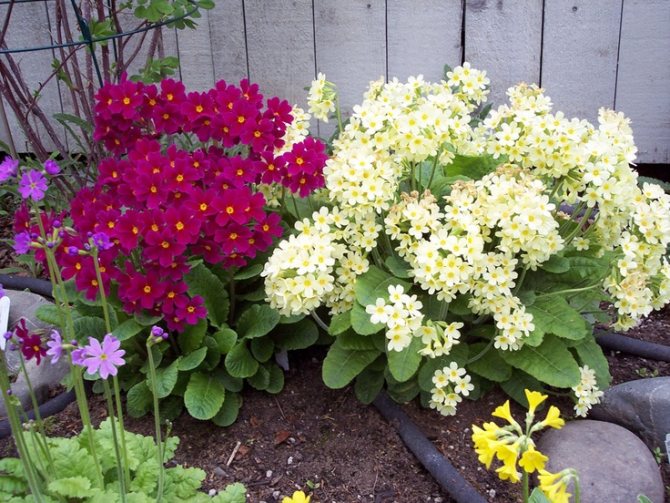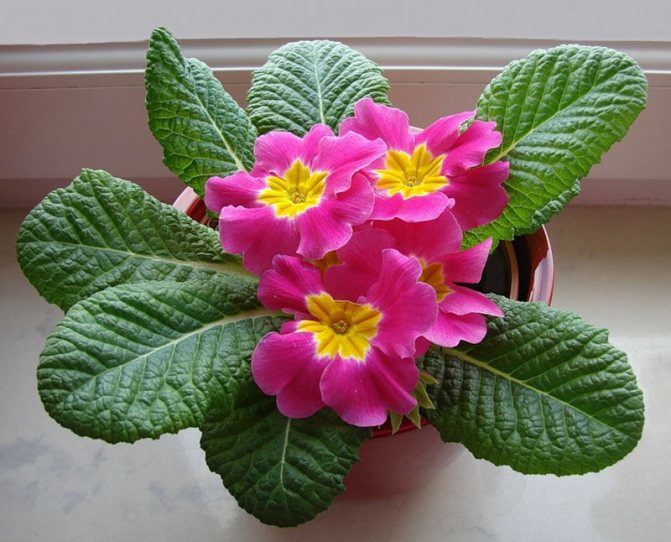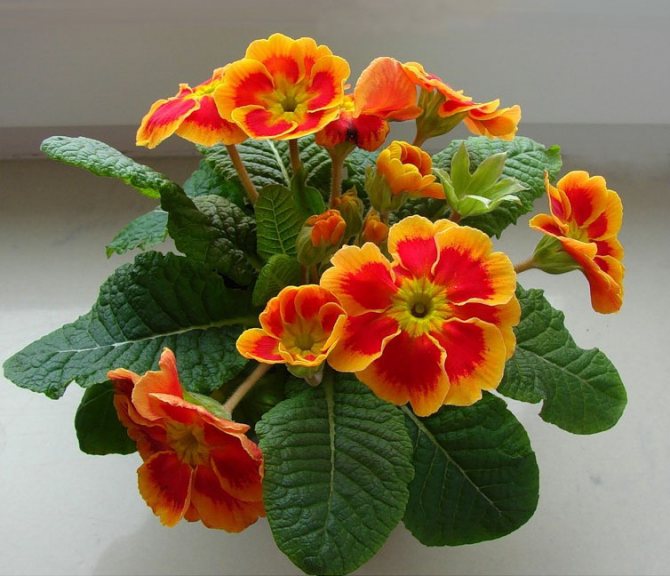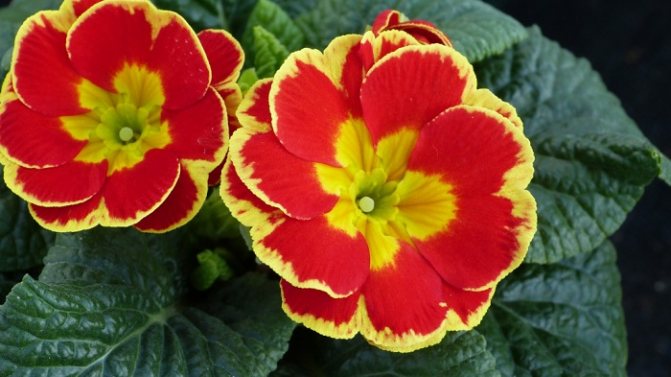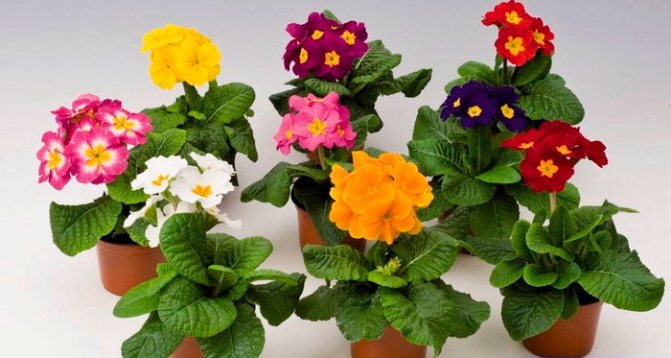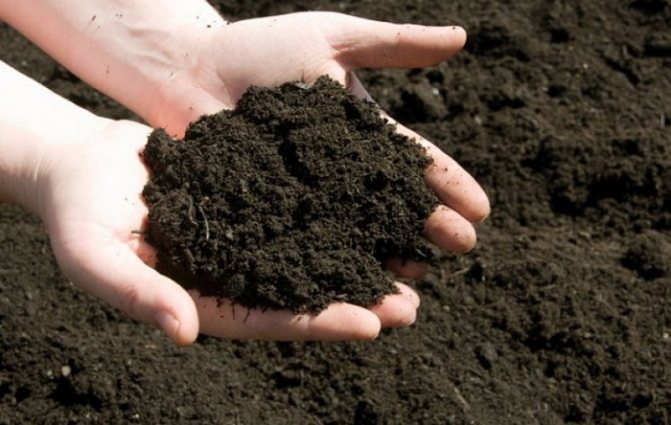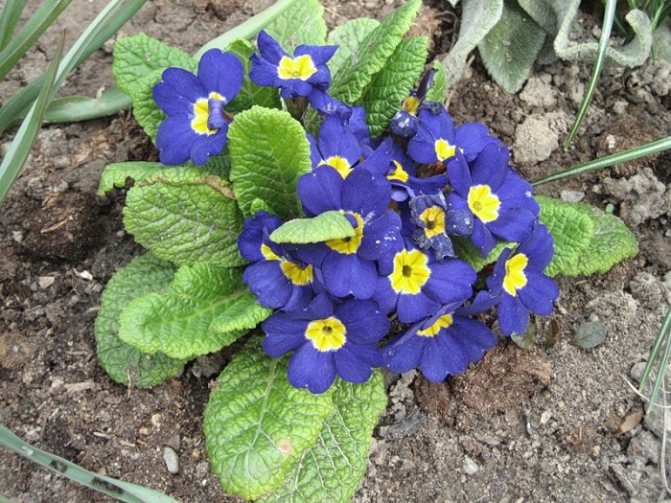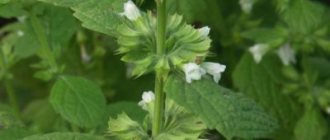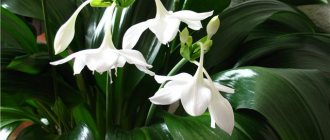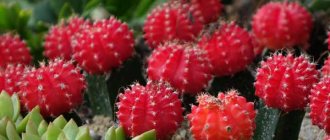In the last winter weeks, spectacular flowering plants appear on sale, which are called primroses... Their flowers can be painted in a variety of colors, and they are located in the middle of the rosette of green leaves, which cannot but please with its spring freshness.
A plant such as a primrose (Primula), which is also called a primrose, is directly related to the family of primroses (Primulaceae). This plant is herbaceous and can be found in the wild in temperate regions such as Europe, North America, Asia, and China. This genus unites more than 500 plant species, among which there are both perennials and annuals.
The leaves of this plant are collected in a basal rosette. They are covered with a small pile or wrinkled, as well as heart-shaped, and they are located on long petioles with jagged edges.
Primrose flowers can be painted in a wide variety of color shades. The flowers are either collected in umbellate or racemose inflorescences, or are solitary. This plant blooms for a long time.
A primrose is grown like a garden plant, and flowers appear on it at the very beginning of spring, which is why they are also called primroses. This plant is medicinal and has long been used for the preparation of various medicinal products. So, tea made from flowers is drunk in order to strengthen the nervous system. Soothing and diaphoretic decoctions are also made. And in spring, salads are prepared from young primrose leaves. And that's all, because only 1 leaf of this flower is able to saturate the body with the daily norm of vitamin C.

You should also know that there are indoor types of such a plant that can cause allergies (most often it is obconica). When working with such primroses, flower growers notice that irritation or a rash appears on their hands. In this regard, these flowers are recommended to be placed out of the reach of small children.
At home, perennial primrose obconica is often grown, as well as a large number of different hybrids of garden primrose.
A herbaceous plant such as primrose obconica is perennial and has leaves with a pubescent surface. Leaves, the length of which can reach 10 centimeters, have a rounded shape and wavy edges, they are located on long petioles. The flowers collected in umbellate inflorescences are colored pink, blue, white, red or lilac.
Indoors, a garden primrose is grown as a forcing plant, and it is often they are found on sale at the very end of the winter period. Such garden hybrids practically do not cause an allergic reaction. When the plant has faded, it can be planted in open ground. Most of these species successfully winter at home and bloom for several years.
Description and types of primrose
The indoor primrose is a flower about 25 cm long. The primrose is an annual or perennial. For planting at home, annual varieties are more often chosen. Indoor primrose leaves are about 7 cm in diameter.The inflorescence contains five petals, ending with 3 lobes. The indoor primrose flower has a varied range of colors. Flowering occurs about 2 times a year (spring and winter) and can last for several months.
It is believed that this indoor flower has healing properties, however, some types of flower, in direct contact with human skin, can cause an allergic reaction.
Consider the main types and varieties of primrose indoor plants.
Indoor primrose soft
Comes from China. It is a perennial of medium length. Has one rosette of root leaves. On a long root, oval-elongated leaves of a light green color appear. The peak of flowering occurs in the spring and lasts for about three months or more. The inflorescence can reach up to 10-12 flowers. In its natural environment, the flower is colored lilac, but the cultivated plant has a variety of colors. The most common varieties of soft room primrose:
- "Snow Queen" - inflorescences of whitish shades;
- "White Pearl" - according to the name, the flowers have a pearl color;
- "Mars" - lilac inflorescences;
- "Juliet mixed" - has double inflorescences with double color - lilac and pink;
- "Enchantment" - bright blue inflorescences.
Primula inverse conical (obkonika)
The most popular variety of primroses. Comes from the family of Chinese primroses. It has a size much smaller, the primrose is soft. Can reach a maximum of 20 cm in length.
Leaves are oblong ovoid with "jagged" edges on a long petiole. It blooms in spring and winter, but blooms almost continuously under good conditions. Flowers are located on a short peduncle, due to which the plant looks like a hat of flowers. In their natural habitat, the flowers are lavender in color. A cultivated plant can have lilac, purple, pink, lavender color. Some varieties of reverse conical primrose cause an allergic reaction. Inverse conical primrose (obkonika): photo The most popular variety is “Twilly Touch Me”.
Primula stemless (common)
Primula stemless refers to hybrid. This means that it can be grown both indoors and outdoors. Natural habitat - Europe, Asia and Africa. Has a miniature size, can reach a maximum of 20 cm in length. The long roots have bright green elliptical leaves.
Flowering lasts quite a long time - from April to June. Flowers are arranged singly. Peduncles are high enough. In size, the flower can reach from 2 to 4 cm. The most common varieties of stemless primrose are:
- Primrose "Sрhinx Apricot" - flowers have a double color: red gradually turns bright orange;
- Primrose "Sрhinx F1 neon Rose" - bright, crimson inflorescences;
- Primrose "Eclipse Violet with Rim" - has a purple color with a gold border.
Description, biological features
In terms of habit, flowering duration, individual nuances of agricultural technology, primrose obkonika is on a par with Saintpaulia and Pelargonium.
This is a small potted plant 25–30 cm high. By nature it is a perennial, but since it blooms most abundantly in the first year, cultivation is practiced in a one- and two-year culture. The herbaceous plant forms a rather lush rosette of large velvety leaves of a rounded shape with a wavy edge. The petioles are long, pubescent. Blooms in 4–5 months after sowing the seeds - by this time a rosette of 8–10 leaves is formed.
Primula obkonika belongs to the large-flowered representatives of the family. Flowers 6–8 cm in diameter are collected in multi-colored umbrellas on long stems and are located in the second tier above the dark green foliage. One plant throws up to 10 peduncles at a time.When sown in summer, it blooms from February to May, blooms again in autumn and pleases the eye with bright bouquets until December.
To successfully cultivate this indoor beauty, pay attention to some of the biological characteristics of the species.
- A herbaceous plant in its natural form grows in the lower tier of subtropical flora, on the slopes of hills, on the banks of water bodies, therefore it prefers bright, but diffused sunlight in combination with moist soil and good aeration of the root system.
- Primula obkonika prefers loose nutrient soil with a slightly acidic reaction (pH from 5 to 6 units). The substrate for it should contain high-moor peat and leafy soil - components that regulate acidity in the desired range.
- Despite its subtropical origin, the plant loves moderate heat, even coolness (15-18⁰ C). This is normal. This is how it adapts to the light conditions of the northern hemisphere.
- P. obkonika differs from most indoor primroses in that it does not need a period of cold temperatures and rest to form buds. With proper care, it can bloom all year round - in the autumn-winter period on the windowsill, in the spring and summer - on an open balcony, terrace, flower bed.
Note! Primrose obkonik refers to plants that cause an allergic reaction, which must be taken into account when leaving. It is not poisonous, but all parts in contact with the skin cause redness and itching, the smell of flowers irritates the nasal mucosa. It is not recommended to place a flower in a bedroom, children's room.
How to care for primrose at home
The flower loves and demands to be carefully looked after. Annuals are often thrown away after it has faded. But even for a short period of use, it is important to create a comfortable environment for the primrose.
- Watering.
During the flowering period, primrose needs abundant watering. For irrigation, settled water is suitable. It is imperative to monitor the condition of the soil - it should not dry out. You should try to keep the topsoil moist. If the primrose is perennial, then after it fades, watering must be stopped. It is important to give the soil a little rest (dry out). Do not overfill the flower with water, otherwise rotting may begin. Therefore, it is better to fill the pot with water or submerge the pot completely in water, for example, in a basin of water. - Temperature and humidity.
During the flowering period of the primrose reverse conical, it is necessary to maintain the temperature regime within 16-20 degrees. For other species, the optimum temperature is 10-12 degrees. To maintain moisture, you can regularly spray the primrose leaves from the bottom side or keep an open container of water near the pot. - Lighting.
Indoor primrose loves western and eastern window sills. The bright rays of the sun can damage the flowers of the plant. Also dislikes shadow. - The soil.
The flower loves fertile sod or deciduous soil mixed with peat and sand. The creation of a drainage layer in the pot is necessary. Coniferous needles can be used to add acidity to normal soil.
Propagation by leaf cuttings
There is another option for obtaining new primroses bushes - leaf propagation. You need to choose a healthy plant and do the following:
- prepare a pot or container with peat and a layer of sand about 2 cm;
- with a sharp knife, cut off a leaf with a bud from a primrose;
- cut the sheet itself in half, the cut should turn out to be even;
- lower the sheet at an angle into the sand by about 1 cm;
- water and put in a cold place, not forgetting to water further.
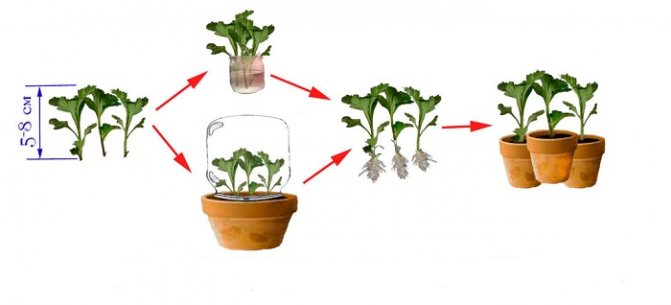

After three months, if everything was done correctly, 3-4 sheets will appear. Then it can be transplanted into a larger pot.
Growing primrose from seeds at home
The best breeding season for primrose with reverse conical seeds is in April and May. Soft primrose propagate by seeds, preferably in summer.
For planting primrose flowers, fertile deciduous soil mixed with sand is the best option. The pot is filled with prepared soil, seeds are sown into it. You do not need to cover the seeds with soil from above, just moisten the soil a little (make sure that it does not appear). Glass is placed on top of the pot. Seeds need periodic airing and spraying. The first shoots will appear in about a couple of months.
When to transplant home primroses
Like all indoor crops, primroses grow over time. They need to be moved in larger containers. And due to the transplant, the soil is renewed, which improves growth and bud formation. Experts recommend moving the flower to a new pot one year after planting, then the procedure should be repeated after 2-3 years.
For a transplant, a wider container is needed so that the overgrown primrose is not cramped. The soil must meet certain requirements, which were mentioned above. Don't forget about drainage. We completely replace the soil with a new one, therefore, when removing the plant from the old pot, carefully shake off the roots. But at the same time, it is important not to damage the outlet, so all actions must be done very carefully. The best time for a transplant is September - the very beginning of October.


Primrose prepared for transplant
Possible diseases of primrose
Indoor primrose is most susceptible to fungal diseases, in which the leaves and roots of the plant rot. Viral diseases can also kill the twig.
If the leaves of the primrose began to fade, turn yellow, turn brown and dry, yellow dots appeared on them, and later - large discolored and dried out areas, then the plant is surely affected.
If on the lower, less often on the upper surface of the leaves you see small 2-3 mm white insects and wingless yellowish larvae, then the plant was struck by such a pest as.
If the primrose flowers are covered with small light specks, and the leaves turn brown at the edges, this is a sure sign of pests that actively reproduce in flowers, as a rule, in the area of the stamens.
See also a video about caring for primrose at home:
Among the huge number of varieties of garden primroses, there are several types for growing at home. Indoor primrose is an ideal plant for northern windowsills, the flower blooms in early spring, for which it is ranked among the primroses of the flora kingdom. The ancient sagas of the Scandinavian peoples compare the plant with the keys with which the goddess Freya opens the gates in spring. This article is all about the proper cultivation and care of indoor primrose at home.
Multicolored indoor primroses begin to bloom in early April.
Usually primroses bloom for a short time, but very bright, catchy. Amazing flowers are distinguished by a rich palette of colors from the most delicate pastel colors to bright red or purple colors with contrasting eyes in the center of the flower. The eye can be intense yellow or pure white.
At home, most often grown primrose reverse conic (Primula obconica) or annual (Primula malacoides). In recent years, stemless varieties (Primula vulgaris and Primula acaulis) have been used for growing on windowsills. Each species has its own characteristics, secrets of cultivation and nuances in care, but these plants have the following requirements in common - plants do not tolerate heat and bright sunlight.
Primula stemless
More recently, stemless primrose began to grow indoors. To date, more than 50 varieties are known that are recommended for window sills. Every year breeders bring out new varieties with bright huge flowers; resistant to dry indoor air; compact size; with a delicate aroma.
It is worth noting that in all primroses, not only flowers have a smell, but also leaves, peduncles and other parts of the plant. Most of them emit allergenic substances into the air, cause irritation of the mucous membrane if plant sap gets on it, so it is not recommended to sniff the plants.
Stemless primroses are short plants.
Primula stemless in nature grows in the foothills of the Caucasus and Crimea, where it forms pillow-like thickets of compact undersized bushes. The leaves are elongated, with short petioles, forming a dense rosette, in the center of which a bouquet of decorative flowers rises. Up to 7 bright flowers can bloom on the plant at the same time. The first wave of flowering coincides with the beginning of April and continues until the end of spring. Sometimes plants bloom again in autumn, but hot summer time is absolutely not suitable for flowering.
Agrotechnical cultivation
Stemless primrose requires some care when grown indoors:
- Lighting is partial shade, direct sunlight is destructive for the plant.
- Watering is regular, but indoor primrose categorically does not tolerate stagnant water and overflows. Do not leave water in trays, and also carelessly water primrose from a watering can, falling into the center of the outlet. Excessive waterlogging can lead to decay of the roots and rosette of leaves of a wonderful plant.
- Top dressing - regular application of fertilizers containing phosphorus during budding and flowering.
- The soil for planting is light, fertile, with a high content of peat.
- Air humidity - in extreme heat, it is useful to humidify the air around the bowls with planted sockets.
- Pot sizes - young plants of stemless primrose are planted in small pots with a diameter of 8-10 cm, pots or pots with a diameter of up to 15 cm are suitable for adult plants.
Reproduction
A bouquet of magnificent primroses.
For the reproduction of perennial primrose, you can use parts of the mother bush, which are obtained with the annual transplantation of the plant in early autumn.
The annual transplantation of plants cannot be neglected, otherwise they quickly stretch out and disappear.
During the autumn transplant, the mother bush is divided into separate parts that have a growth point and a root lobe. Young plants are planted in small pots, trying not to burrow into the ground, watered abundantly and left on a light window. If young plants are slightly wilted, they can be placed in a greenhouse to restore leaf turgor.
Seed primrose propagation is more troublesome. To plant small seeds in the ground, you should wait until the end of winter. If at this time there is still snow on the street, you can sow seeds in the snow. To do this, prepare low bowls with light soil, on top of which snow is poured in a thin layer. Small seeds are scattered over the snow, then the bowl is placed on a warm windowsill, covered with glass. The snow will melt, turning into water, which is absorbed into the soil, carrying small seeds into the soil. Sowing seeds on snow allows you to avoid stratification of the seed in a cold place (usually they are frozen in a household refrigerator).
Young seedlings dive in the 5-leaf stage. In the first year, the plant is not allowed to bloom - all the buds that appear should be carefully broken off.
Primula reverse conical
Reverse conical primrose is much higher than other species.
The primrose is reverse conical, like a houseplant, not at all like Primula acaulis. This beauty reaches a height of 40-50 cm, has a spreading bush with rounded leaves on long fragile petioles. Original flowers rise above a large rosette, resembling a graceful bouquet. The color of primrose obkonik is very diverse, but more often the plant blooms with delicate colors of pastel colors. Each peduncle is capable of carrying up to 20 open flowers. Primrose is the perfect plant for a gift or interior decoration.
The flowering of primrose inversely conical in room conditions can last indefinitely, the break occurs only in the hot summer months.
Agrotechnical cultivation
Indoor primrose reverse conic develops well at home, subject to the following care rules:
- Lighting - shade or partial shade, the plant needs protection from direct sunlight and dry air.
- Watering is regular, abundant. Water for irrigation must be defended for a long time.
- Top dressing - regular application of complex fertilizers, the period of budding and flowering of the plant is useful to feed with phosphorus.
- Planting soil - light, fertile peat-based soil is ideal.
- Air humidity is high in hot or dry weather.
- Pot size - growing room obkonik primrose is best done in pots with a diameter of 20 cm or more.
Reproduction
Reverse conic primrose is bred exclusively with seeds. It takes about six months from sowing to the appearance of flowers, so sowing of seeds begins in the middle of winter.
For sowing, use low bowls filled with a light soil mixture. Seeds are sown on the surface of the soil, watered, and greenhouse conditions are arranged, for which it is quite enough to cover the bowl with plastic wrap. Seed germination lasts up to 3 weeks. At this time, it is worth monitoring the moisture content of the soil, preventing it from drying out. The ideal temperature for seed germination can be considered + 20C.
Young primroses dive at the stage of appearance of 2-3 leaves, using peat pots with a diameter of 6-8 cm for transplantation.
Reverse conic primrose was long considered a strong allergen, until Dutch breeders developed new varieties that were devoid of odor.
flowering primrose
... It is appreciated for its long flowering and variety of colors.
Currently bred varieties with double, two- and even three-color flowers
.
Should you keep primrose in your home?
There is an opinion that a beautiful flower is poisonous, and therefore dangerous and especially undesirable in an apartment where there are children and pregnant women. This is not entirely true. The plant sap really contains an alkaloid that is harmful to humans. But if you do not allow the substance to come into contact with the skin, then nothing terrible will happen.
Important. Even if you get your hands dirty with primrose juice, you just need to wash them well with soap and water. During flowering, the plant emits volatile compounds that can cause allergies, but only in those who are initially prone to it. For everyone else, the flower is harmless.
Moreover, scientists note that primrose has numerous beneficial properties. No wonder it has long been used in folk medicine. Decoctions for headaches and vitamin deficiency were prepared from its dried buds. This remedy also helped from stagnation of bile, reduced immunity, liver diseases.
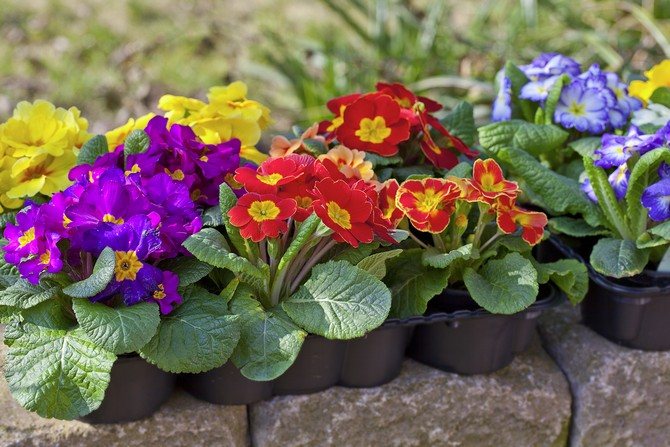

Home primroses are incredibly decorative
Lotions with primrose leaves helped with joint and back pain. From the sap of the flower they made ointments for eczema. Today, the plant is added to pharmaceutical herbal preparations of expectorant, diuretic and laxative types.
And primrose also has a very positive energy. It is not for nothing that in Russia it is called the "key" that opens the door in spring. Spring warmth, solar energy and a pacifying atmosphere brings this plant to every home. If you put it on the windowsill, then very soon you will notice that there are fewer scandals and quarrels in the family. Insecure, squeezed people should keep a flower next to them, because it helps to reveal inner strength and establish communication with others. Primrose will help creative people overcome the crisis of inspiration. Another plant is able to absorb negative energy brought into the house from the outside, relieve fears and nightmares.
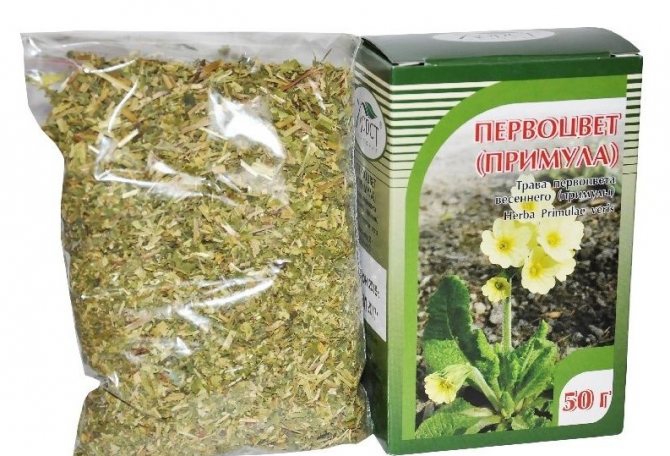

Primrose is included in herbal preparations
Care secrets
Home care for primrose is not particularly difficult. The main thing is to create a plant appropriate growing conditions
... So, how to care for this primrose:
# 1: choosing a location
In natural conditions, primroses grow in shade. Therefore, when grown in a house, they should be placed on the east and west windows. They need bright but diffused lighting.
.
All types of primroses prefer coolness. The optimum temperature for keeping them is 10-15 ° C. When they do not bloom at higher temperatures
.
# 2: we compose the soil
For the successful development of primroses, a soil with a slightly alkaline reaction is required. When self-compiling a mixture of earth, use 2 parts of peat, turf and leaf land
with the addition of 1 part of pure river sand.
Potash fertilizers and bone meal are also added to the soil. From ready-made substrates of industrial production for growing primrose
the most suitable primer for cyclamens.
# 3: feeding properly
For feeding primrose, solutions of organic and mineral fertilizers are used. They are brought in during the period flowering no more than 2 times a month.
For example, you can use a complex mineral fertilizer for flowering indoor plants mixed with humate.
Attention!
Primrose is very sensitive to excess fertilization. Therefore, when using them, the concentration is reduced by 2 times from the recommended one.
# 4: proper watering
All types of primroses require frequent and abundant watering. Even a slight overdrying is destructive for them. Them the leaves immediately turn yellow, and the flowers wither
.
It is advisable to use water for irrigation pre-separated, at room temperature. The plants are additionally sprayed once a week.
No. 5: timely transplant
Once every 2-3 years, primrose must be transplanted. The transplant is carried out after the end of flowering.
... During it, highly overgrown plants are divided into several parts.
The new pot should be slightly larger than the root system. When choosing it, preference should be given wide and shallow containers
.
This video tells how to care for room primrose in the autumn - winter period.
Forcing primrose


For distillation, as a rule, they take a two-year-old bush or an older divided plant. The flower must be dug out just before the frost, while it must be taken with a large lump of soil. The primrose can be immediately planted in a flower pot or stored in a drawer. For storage, plants are placed in a greenhouse, closed for the winter with frames and dry foliage, or in a basement. The temperature there should be about 4-8 degrees. If it is warmer or lighter, then only foliage will grow intensively. In this case, the development of buds will be slow or completely absent. There is no need to water the plants.
In the last weeks of January, the first - February, you need to put the primrose in a bright room, where the temperature will be no more than 18 degrees. In this case, watering should be resumed gradually. There are species that begin to bloom in February, others appear in March or April. To prolong flowering, you need to place the primrose in a room with a temperature of no higher than 10-15 degrees.
After the end of flowering, these plants are not thrown away. They are placed in a bright, cool place and provide moderate watering. In the spring they are transplanted into the garden. After 2 or 3 years, these primroses can be divided again and used for distillation.
Diseases
The most common disease of indoor primroses is root rot. The main reasons for its occurrence excessive watering and lack of drainage
... Developing rot can be identified by the following criteria:
- Withering away.
- Yellowed lower leaves.
- Black spots at the base of the rosette.
When these symptoms are detected, the plants will immediately spill with fungicide solution
... For example, you can use a foundation solution prepared at the rate of 2 grams per 1 liter of water.
If the disease continues to progress, the bush is shaken out of the pot and washed under running water. After that on the plant remove all rotten and blackened places
... The primrose treated in this way is planted in fresh soil.
This video tells how to prolong the flowering of obkonik primrose, how to feed it, how to water it.
Plant transplant
For growth and stimulation of flowering, primrose must be transplanted. To do this, you should adhere to the technology of how to transplant a primrose. Young plants are transplanted once a year, adults - once every two to three years.
For a correct transplant, you need:
- Choose the right pot. The new container must be wider than the previous one.
- The soil and drainage must be selected specifically for the primrose.
- When transplanting, the socket must be on the surface.
- The earth needs to be replaced completely.
When transplanting, be careful not to injure the fragile root system. Primrose is transplanted in the fall, around the end of September.
In the interval between transplants, the soil around the plant needs to be renewed from time to time.
Reproduction
The easiest and fastest way to reproduce indoor primroses is to divide the bush. It is started after flowering. For this the plants are carefully knocked out of the pots
and with a sharp knife cut into separate sockets.
You can also propagate primroses by sowing seeds. To do this, you need to prepare a plastic container of a suitable size and loose nutrient soil.
Advice!
Before sowing, the ground surface must be carefully leveled and compacted. This will avoid seed loss.
Sowing is carried out without embedding in the soil, the seeds are evenly distributed over the soil surface. After the end of the sowing work the container is closed with a plastic bag
and placed on stratification.
To do this, you can use an ordinary household refrigerator. The period of stratification must be at least 1 month. During this time, crops are periodically ventilated.
.
After the expiration date, the container is placed in a warm, well-lit place without direct sunlight. After 5-7 days, the first shoots are already visible on the soil surface. When the first true leaves appear, dive into more spacious containers
.
Features of seasonal care
Primroses differ from other indoor crops in that they have an active growing season in the winter. It is from the autumn that the culture prepares for flowering. But in order to achieve abundant and long-term flowering, care must be taken to ensure a dormant period.
After the bush has faded, it is placed in a well-ventilated room, slightly shaded. The air should be cool + 10 ... 16 ° С. Since the primrose rests in the summer, it is not very easy to provide cool conditions. You can plant a flower in the garden near shady trees. If flowers begin to bloom during the dormant period, they must be removed.
Distillation
Blooming primrose can be timed to a specific date, for example, by March 8. Most often, hybrid varieties of primrose are driven out. For this sowing in the middle of summer
seeds. In this case, no stratification is required.
The first shoots appear in 2 weeks. At this point, it is very important to protect them from direct sunlight. After 5 weeks, the first pick is carried out
... After another month, primroses are seated in separate pots with a diameter of 9-10 cm.
The temperature during rooting should be around 15 ° C. In the future, it begins to gradually decrease to + 1-3 ° C. In an apartment such conditions can be created on a glazed loggia
... Lowering the temperature is necessary for the setting of flower buds. In this case, the total duration of the cold period should be at least 6 weeks.
During the forcing period, plants need bright diffused light.
... The more it is, the larger and brighter the flowers will be. And also primroses need to be fed. For this, complex mineral fertilizers are used. They are brought in once a week.
As soon as the first buds appear on the primroses, the temperature is raised to + 8-10 °, to speed up the process, its increase is permissible + 15 ° C. Higher temperature is unacceptable
, under such conditions, the quality of flowering suffers greatly.
How and what to feed
It is not necessary to constantly stuff primrose with fertilizers. An unpretentious flower needs stimulating feeding only during certain periods. In flower shops, you should purchase mineral fertilizers with a complex of mineral elements. You need to add them to the soil during the flowering period: about once every two weeks.
This will make bud formation more active. If you start feeding earlier, then you can achieve the exact opposite effect: the leaves will begin to grow better, but the flowers will not appear. During the dormant period, the plant does not need fertilizers.
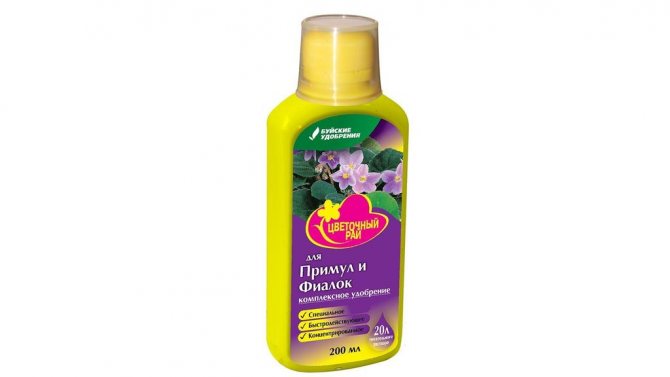

Fertilizer for home primrose
Dangerous properties of primrose
When growing a primrose, it should be remembered that the hairs of its pubescence contain a rather strong poison of vascular action. This poison on contact with a plant, it gets on the surface of the skin
causing redness and itching.
Attention!
In case of individual intolerance, a strong allergic reaction may additionally occur. To prevent this, it is recommended to use rubber gloves when caring for the plant.
If irritation occurs after contact with primrose, it is recommended to rinse the affected skin plenty of warm water with added soap
... If there is no improvement, you should see a doctor as soon as possible.
Primula is a perennial herb of the Primroses family. The root system is superficial and grows rapidly. The height of the stem is 10-25 cm. The leaf plates are solid, wrinkled, collected in a root rosette, painted in a dark green color. Primrose is grown as an ornamental flowering plant. The flowers are of the correct shape, consist of 5 petals, rise above the bush on a short peduncle, are located singly or racemose, umbellate inflorescences are collected. Varied in color.
Flowering usually begins in the spring, but varieties that bloom in the winter are bred.
In its natural environment, it lives in the temperate climatic zone of Europe, Asia, North America, China, where it grows on moist soil near water bodies.
Characterization, breeding and reproduction
This delicate plant is able to fend for itself and until recently was considered a strong allergen, leaving after contact with it in ten people out of a hundred itching, redness and rashes on the skin. As self-defense, it uses primin, a substance secreted by the glands of the hairs that cover the stems and leaves.
A mixture of turf and sand is used to germinate the seeds.
The Dutchmen who bred the group of primroses Touch me saved the gardeners, which loosely translated in relation to the existing problem of plant toxicity can mean: the plant is accessible and it is quite possible to touch it.
Primrose is bred with seeds. It takes about six months from sowing to flowering, therefore, in order for the plant to bloom in the second half of summer, it must be sown in January. A mixture of turf and sand is used to germinate the seeds. Seeds are sown on the surface, without embedding in the ground, cover the container with glass and regularly spray the soil, preventing drying out. At a temperature of 20-22 ° C, seedlings will appear in 2-3 weeks, after which the container with the seedlings is placed in a bright place, and the temperature is lowered by several degrees.
When 1-2 leaves appear, the seedlings dive, leaving a distance of 3-4 cm between them. So they grow until the leaves of neighboring plants close. Then a second pick is carried out, planting the shoots every 8 cm.Plants are transplanted into the pot when, after the second pick, the leaves of neighboring plants close again. From this time on, you can start feeding with a solution of bird droppings, full mineral fertilizer or mullein solution. An adult plant can subsequently be propagated by cuttings or dividing the bush, which, like the transplant, is carried out during the rest of the plant between flowering.
Back to the table of contents
Growing room primrose from seeds at home
Propagated by primrose seeds and vegetatively. The time depends on the type of primrose. In general, this is the period from mid-spring to early summer.
- Fill the container with a mixture of leafy earth and sand, spread the seeds as rarely as possible over the surface of the soil, without deepening, otherwise they will not sprout.
- Spray with a spray bottle. For successful germination, cover the crops with glass or foil.
- Place in a bright place with an air temperature of 16-17 ° C.
- Seedlings will appear in a couple of weeks. Shelter needs to be removed.
- Leave the lighting and air temperature the same.
- Water sparingly, thinning as you grow.
- After about 3 months of life, young plants will get strong enough, then plant them in separate containers.
- When transplanting into separate cups, use something as a "shovel", for example, a fork, to gently pick up the seedlings with an earthen lump, without disturbing it, and transfer into a more spacious container.
- The transplanted plants are gently watered.
- Further care is simple: you need moderate moisture and heat, diffused lighting. When the violets grow up, they are transferred to permanent pots.
The main stages of caring for indoor primroses
To prevent the plant from dying, blooming in time, pleasing the eye with the brightness of the foliage and the beauty of the buds, attention should be paid to each stage of care. If you miss something, then problems will surely begin. Therefore, it should be well remembered that primrose requires:
- high quality soil;
- creation of optimal lighting conditions;
- a certain temperature regime;
- correct watering;
- timely feeding;
- regular transplant.
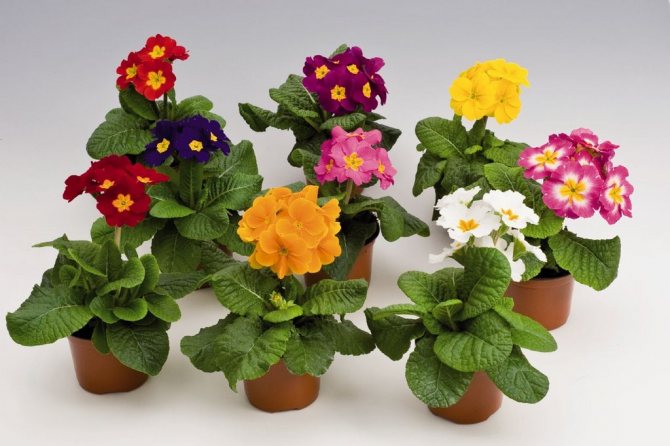

For primroses to bloom luxuriantly, they need some care.
What should be the quality of the soil?
Primrose requires a special soil that has a moderate level of acidity. If this figure is too high, the plant will die. Therefore, you should purchase in the store a ready-made mixture containing three leading components: peat, sand and disinfected soil. But you can prepare the substrate yourself, in this case, mixing the ingredients for the soil mixture, you need to observe the following proportions: 1 part of sand, 1 part of peat and 1 part of earth.
Video - How to properly care for home primrose
Be sure to lay drainage at the bottom of the pot. Primrose is very easy to pour if moisture does not leave the soil naturally. The roots of the plant will start to rot and it will die. The role of the drainage layer is played by small pebbles, expanded clay balls, etc. Tanks for the soil should be chosen of medium size and not too high. Then, when you transplant an adult plant, you will need to purchase a larger pot - its diameter should be 4-5 cm larger. Then the primrose can take root without any problems and begin to grow well.
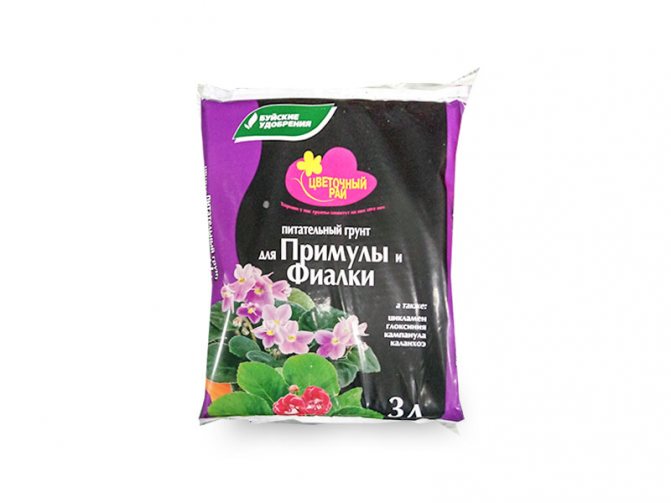

Home primrose needs a special substrate.
Lighting conditions and temperature
Despite the fact that in nature, primrose is a primrose that blooms in early spring, when the snow has not yet completely melted, this plant loves warmth very much. This characteristic is especially true for domestic varieties. They do not tolerate drafts and cold air, and therefore it is not worth keeping them in a cool, let alone unheated room. The temperature at the place where the primrose should be placed should not be less than +16 degrees. During the period of active flowering, the indoor culture should be kept in a room with an air temperature of + 18- + 20 degrees.Compliance with this condition will extend the time of bud formation. And the flowering will be not only longer, but also abundant.
A delicate flower needs good lighting during the flowering period, and in general it loves bright places. Therefore, you should place the plant near windows facing the east side. But primrose must be protected from too bright sun - an abundance of ultraviolet radiation and direct sunlight can lead to leaf burns. The flower, as a rule, does not need artificial lighting.


Primrose should be placed next to windows facing east
Proper watering technique
The moisture requirement for primrose varies with the season and life cycle. This is not to say that this plant is water-loving, but it does not tolerate aridity either. It is necessary to ensure that the soil does not shrink into a lump, but also does not ooze moisture. In both cases, the root system will suffer. And flooding can also provoke rotting of leaves and stems. If you allow it to dry out, then you can bring down the flowering cycle. And then you will have to wait for a very long time until new buds are tied.


Two options for watering primrose
The most abundant watering is required during flowering - you need to add water to the pot every day. It is also necessary to moisten the soil during the dry summer months. But during the dormant period, when the plant has already completely dropped the buds and does not yet plan to form them, you can water it once every 2-3 days. Water must be used at room temperature, previously separated. To do this, it is enough to hold the collected water for several hours or days in the room, but it is more useful to put the container on the balcony or even in the open air - in the sun.
Important. There are two ways to moisturize primroses. Root irrigation involves the introduction of water into the soil at the base of the outlet. But in no case should moisture get inside it. You can pour water into the sump - this is a more convenient and safer way. So the soil will always be evenly moistened.
Table 2. Step-by-step instructions for watering room primrose
| Step, no. | Photo |
| Step one: pour tap water into a regular plastic bottle. | |
| Step two: wait - it should settle for a few hours. | |
| Step three: Transfer the water to a watering can and gently moisten the soil from it at the very roots. | |
| Step four: if the plant has a pallet, then add water to it to the desired level. |
How to care for primrose at home
Site selection and lighting
The plant is light-requiring, but does not tolerate direct sunlight.
The best place will be windows of the east and west orientation, it grows normally on the northern windowsill.
Air temperature
Do not overheat. The optimum air temperature is around 18 ° C. The plant will be positively affected by lowering the temperature to 12-15 ° C during the flowering period.
Ventilate the room, but keep it away from drafts. In the period March-October, place on the balcony, loggias.
How to water
During the time, the soil should be constantly slightly damp. The rest of the time, water as the topsoil dries. Avoid excess moisture. It is better not to water it again - the leaves can wilt, but the plant will quickly recover after watering. Use bottom watering or apply water by moving around the edge of the pot so that the water does not get onto the leaves of the plant. Drizzle with soft water at room temperature.
You cannot spray the plant. To maintain humidity, periodically place the pot with the plant on a pallet with damp moss, pebbles, expanded clay.
How to feed
During the flowering period with complex mineral fertilizers. Divide the dosage recommended by the instructions in half and apply top dressing every 14 days. The rest of the time, you do not need to feed.
Reproduction by dividing the bush
There is another way to get new primrose bushes - propagate by dividing the bush. The plant should be intact and completely faded. It is advisable to choose a 3 year old bush.It needs to be put in a dark place, but do not forget about watering.
When the stems begin to grow, you can start dividing:
- prepare 2-3 containers or pots for young bushes, fill them with a mixture of peat and sand;
- water the mother plant first, wait until the moisture saturates the ground well, and then carefully remove the bush from the pot;
- the bush is divided into parts so that each of them has a well-developed root system and a growth bud;
- all that remains is to plant new bushes in pots and cover them with glass, placing the pots in a bright but cool place.
- after 3-5 days, when the plants take root, you can remove the glass.
Further, as necessary, they need to be transplanted into larger pots. It is important not to forget about the dressings that need to be done every fortnight. Complex mineral fertilizers are suitable for this.
Diseases and pests of room primrose
Rust, jaundice, anthracnose, powdery mildew, cucumber mosaic virus, tomato spotted wilting virus are possible primrose diseases. To save the plant, it is necessary to remove the damaged areas and treat with a fungicide.
Plant pests: nematodes, spider mites, aphids. It is necessary to carry out an insecticide treatment.
Primrose leaves turn yellow and buds fall off
- Due to excess moisture, rotting of the root system and stems is possible. Get an emergency transplant. Remove the affected areas, treat with a fungicide. Adjust watering;
- The leaves turn yellow. This happens for a number of reasons: high temperature or dry air, the soil is waterlogged, watered with hard, cold water, excessive feeding;
- Discharge of buds, flowers wither quickly. Dry air, high air temperature, lack of moisture in the soil.
Description
Today, there are many traditional primrose varieties as well as large-flowered Dutch hybrids with various decorative properties. Primula obconica (Primula obconica) of the primroses family is one of these plants (other names for primrose obconica are reverse conical, reverse lanceolate). Suitable for growing in gardens and at home.
Indoor plants from 25 to 60 cm in height are actually considered perennial, but since they bloom most decoratively and luxuriantly in the first year, many growers practice growing the plant as an annual.
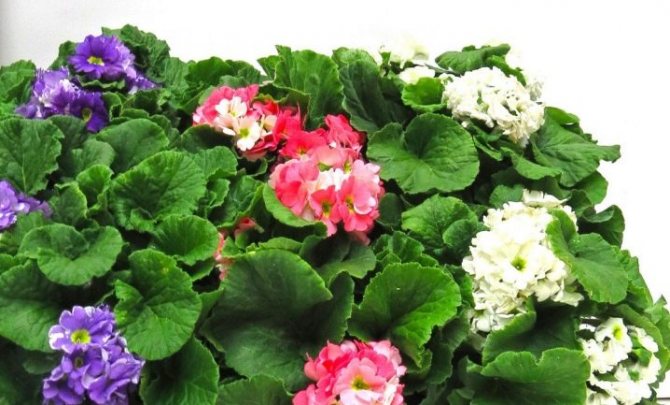

But if you decide to keep the plant for more than one year, this is quite possible. With proper care, the obkonika will delight you with intense flowering for several years in a row. It begins to bloom in about six months from the moment of sowing the seeds and blooms almost all year (in summer, a short break is possible). The color of the petals ranges from crystal clear white to mysterious dark purple. The flowers are conical in shape and are collected in umbrella-shaped inflorescences, towering above the basal rosette of fleecy leaves.
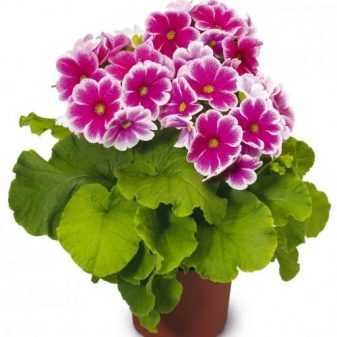

A characteristic feature of traditional obkonika primrose varieties is that its aerial parts have glands that produce primin. This substance, when it comes into contact with the skin of the hands, can cause an allergic reaction in the form of itchy rashes and redness (not in all people, but only those prone to allergies). Despite this circumstance, primroses remain widely in demand among indoor florists. Moreover, it is quite easy to protect yourself from contact with the aerial parts of the plant - just put on gloves on your hands.
Still, it should be noted that experts do not recommend putting primrose pots in the bedroom and in the nursery.
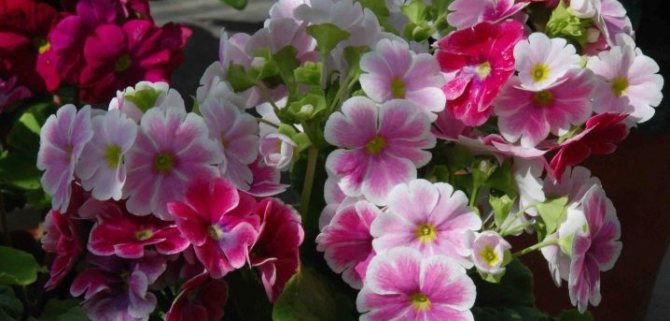

Types and varieties of room primrose with photos and names
Common primrose or stemless Primula vulgaris
Primrose ordinary or stemless Primula vulgaris cultivar Sphinx Apricot photo
Flowering occurs in April-June. The flowers are large, yellow, red, blue.
Varieties:
- Sphinx Apricot - flowers are bright orange;
- Sphinx F1 neon Rose - a variety with crimson flowers;
- Eclipse Violet with Rim - lilac corollas with golden border.
Primrose soft-leaved or soft Primula malacoides
Primrose soft-leaved or soft Primula malacoides variety Snow Queen photo
Plant height is 30-50 cm. The edges of the leaf plates are wavy. Umbellate inflorescence consists of 10-20 flowers.
Varieties:
Mars - the color of the corollas is lilac;
White pearls - flowers of white color with pearl overflow;
Juliet mixed - double flowers with double color: from pastel to mauve;
Enchantment - inflorescences have a bright blue color;
The Snow Queen - the flowers are snow-white.
Reaches a height of 20 cm. It has oblong oval leaves, they are incised into 3 lobes. The flowers are pink, red, blue.
TwillyTouch Me is a group of varieties of this species. The colors can be pink, lavender, purple, combine 2 shades or colors.
Primroses about 30 cm high with large leaves about 15 cm long. The edges of the leaf plates are serrated or wavy. The diameter of the corolla is 4 cm.
Primula Cue - heart-shaped leaf plates, pubescent. The flowers are small, bright yellow in color.
Varieties and hybrids of primrose obkonik
On sale, the most common primrose obkonika grown from seeds of Dutch selection. The old varieties that cause allergies have been replaced by new varieties and hybrids.
- The Touch me variety group amazes not only by the variety of colors and the size of the flower, but also by the fact that it is safe for health. The peak of flowering of an elegant bush is spring and autumn.
- The Grace F1 series is represented by compact plants 20–25 cm high and the same width. Large-flowered mixture contains a bright palette of shades of white, blue, pink, red, lilac.
- The Libre F1 series, like the Touch me, does not emit Primin, an allergenic substance. In a group of 9 shades, flowers of orange color and two-tone color look unusual.
Forcing primrose
Forcing primrose will speed up the beginning of the flowering period of the plant. The process is carried out with the expectation that it should bloom in the house by the beginning of spring.
Flower forcing process:
- To do this, two-year-old bushes are divided into several parts and planted in spacious pots.
- A prerequisite for forcing is to keep containers with plants in a cool place. The temperature in the room with the pots should be between +5 and +8 degrees.
- At the end of winter, containers with flowers are brought into the heat. The temperature in the room should be from +14 to +18 degrees.
- It is important not to forget to water the bushes.
The active growth of the flower begins in a few days. By April, the primrose will bloom in lush color. To extend the flowering period, you need to remove the crop pots in a cool room. Early spring is rarely characterized by hot weather, and the presence of a plant in a warm room leads to the fact that the flower quickly fades, since such conditions are unnatural for it.
The right lighting for primrose
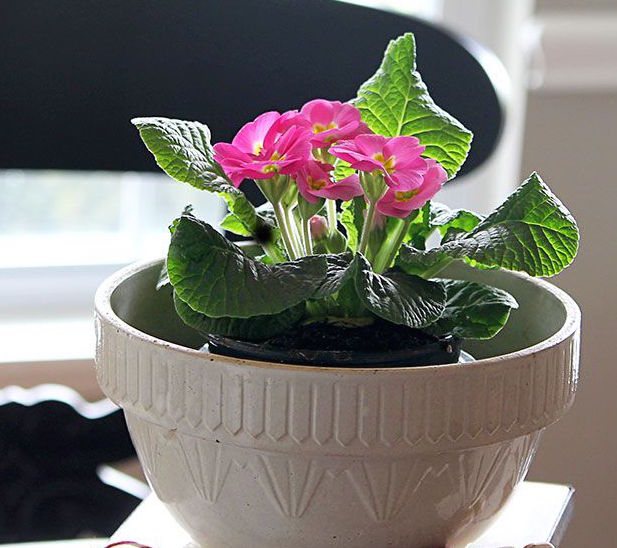

A large amount of light is happiness for a plant of this type, while getting a "tan" is highly undesirable. If direct sunlight "caresses" the leaves, a red border will form on them, which will begin to dry out after a while. If we talk about flowering, then under the sun's rays it is transient and short-lived.
Primrose Obkonik and other varieties should be placed on the windowsills of any room, but not the one that faces the south side. You can also put the pot in the back of the room, but at the same time provide additional lighting using phytolamps.
If there is no other way out but to place the short-stemmed primrose on the southern windowsill, then the plant should be shaded. For this, light blinds, high-density tulle, or a standard landscape sheet can be used. Leaving a flower in this area, most likely, you will not wait for flowering, since the plant needs to provide coolness for the formation of buds.
Should I buy a ready-made mixture?
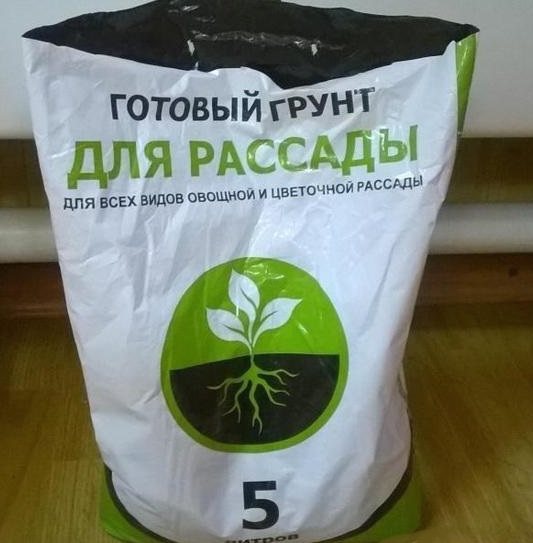

Ready soil mixture
This flower can be planted in the purchased ready-made soil. But it is advisable to create a high-quality composition yourself. To do this, take humus, clean coarse sand and peat. Sod land is also added to these components. Such a composition is friable, while moderately nutritious and permeable.


Potassium permanganate solution
When replanting primrose at home, it is important to decontaminate the soil as well, since these plants are susceptible to the effects of many fungal diseases. It is not at all difficult to carry out the disinfection procedure, for this it is necessary:
- place the prepared mixture in a tight plastic bag;
- put the mixture in the freezer;
- withstand at least 3 days;
- remove the aged soil from the freezer, and let it thaw;
- prepare a strong solution of manganese, and pour it hot onto the mixture;
- after a 12-hour period, the composition should be calcined in the oven at a temperature of +100 degrees Celsius;
- the prepared soil can be placed in the pot.
Further care for primrose at home is not difficult. The main task is to make a competent landing, the main part of which is the creation of drainage. It should be remembered that it is important for primrose that excess liquid disappear as quickly as possible. Otherwise, the roots of the plant will begin to choke and rot.
How to deal with spider mites on room primrose
As with other diseases, this pest appears due to the high temperature in the room and the dry air. When primrose is affected by a spider mite, the leaves of the primrose wither and turn yellow. Yellowish specks appear on the leaves, later - extensive discolored and dried out areas. Spider mites (0.2-0.5 mm) live on the underside of the leaves. For minor lesions, you can treat the primrose with soap or mineral oil. In case of a large lesion with a spider mite, treat with Bitoxibacillin, Fitoverm, Akarin, Vertimek, Molniya, etc.


So, we looked at how to grow indoor primrose, and how to provide this plant with proper care. After providing primrose with decent care, she will certainly thank you with beautiful flowering.
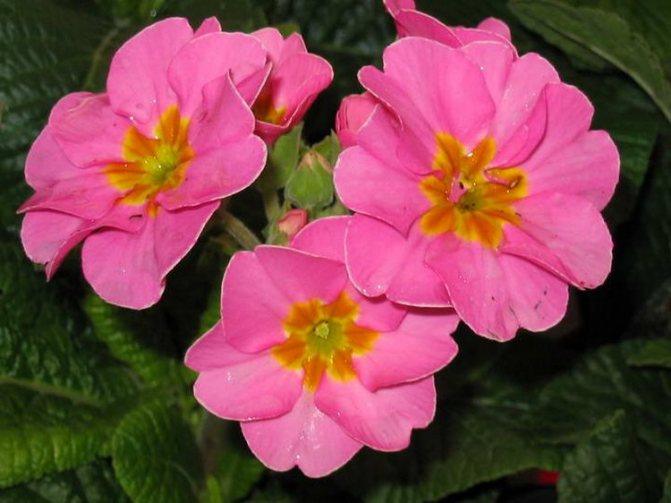

loading ...
Views
When lavender blooms
There are about 400 plant species, which are divided into separate sections. Different primroses require different conditions for growth and development, bloom at different times and look different from each other. This flower can be garden and indoor, annual and perennial.


Flowers of different colors
Among indoor flowers, the most popular are:
- Obkonika is a small perennial flower. If you properly care for the Obkonik primrose, it can bloom all year round;
- Stemless primrose is a small flower, the height of which does not exceed 20 cm. The flowering season begins in April and ends in July;
- Soft. The flowering period of a perennial plant begins in early spring and lasts until early summer.
Among garden primroses, the following varieties are popular:
- Japanese. The shape of the inflorescences is candelabra, it grows to a height of 30-50 cm. Flowering begins in June, lasts 1 month;
- Orchid, or primrose Viale. It differs in its appearance, an inflorescence with flowers-bells is formed on the peduncle;
- High. It grows up to 40-50 cm in height, the umbrella-shaped inflorescences consist of flowers 2 cm in diameter. The flowering season lasts from early April to late May;
- Cushion-shaped. Flowers of this primrose are solitary, not collected in inflorescences. Flowering lasts from early April to late May.
Note! Primrose, when blooming, becomes like a violet.
Primrose - how to propagate a flower?
To increase the collection of primroses, you can use two methods of reproduction:
- Seeds.
Planting material can be collected by mid-summer. It is best to sow before the onset of winter.The scheme is identical to other plants: seed preparation, sowing, watering, covering with foil and picking. - Division of the bush.
Primrose grooming and reproduction is more effective when dividing the bush. There are many dormant buds on the rhizomes, which can give young rosettes. It is better to transplant during active growth, and this is from spring to the end of summer. Another important point is that the more often the procedure for dividing the bush is carried out, the faster young rosettes will form.
Primula - leaf propagation
A young plant can be propagated by cuttings, that is, using a leaf. It needs to be cut so that the stalk is preserved. Another important point is that the presence of a kidney is important for further development. Propagation of primrose by leaf cuttings at home may mean placing them in water or directly into the ground (a mixture of sand and peat). The sheet must be placed at an angle. The reproduction process ends with watering.
Important transplant rules after purchase
When purchasing a flowering plant, it should be remembered that transplantation is possible only when it fades. This rule should be observed not only in relation to perennial primrose, but also to other plant species.
When moving to another pot, it is necessary to add a nutritious substrate, but it is important not to overfeed.
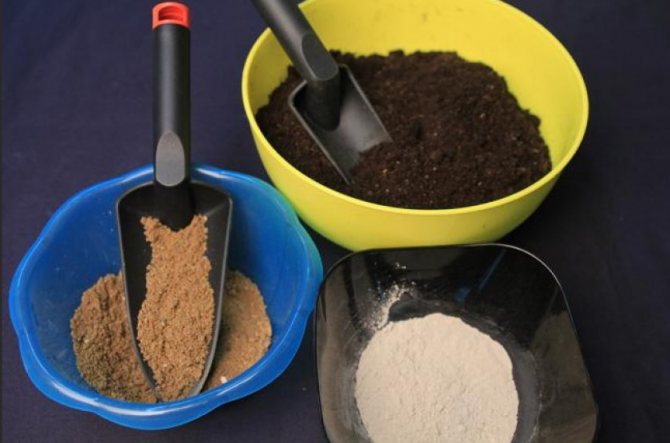

Preparation of soil mixture for transplanting
You can choose peat, sand, and compost as a base for the substrate, in a ratio of 1/1/3. You can pick up such components as sand, turf, leaf, and also coniferous soil in combination 1/1/1/2 (suitable for soft-leaved). Other options are possible, which are specially created and designed to be placed in a pot when transplanting a primrose.
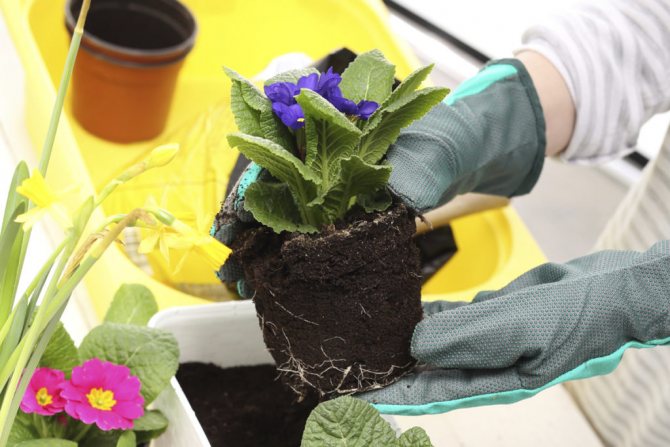

Transplanting primrose
When transplanting a flower, follow these steps:
- Place a drainage layer (approx. 2 cm) on the bottom of the container and smooth it out.
- Place the potting mix (almost all, but leave some), making a depression in the center.
- Transfer the flower from the old pot to the new mixture.
- Sprinkle the edges with the rest of the substrate. Compact the soil, leaving about 0.5 cm to the edge of the pot.
When changing containers, it is very important to evenly distribute the mixture in it. When the pot is completely full, it must be tamped, and if voids are formed, add additional soil composition. These rules should be followed, no matter what type of plant is transplanted, perennial primrose, or any other species.
After the transplant is over, it is necessary to moisten the substrate.... The remaining liquid formed in the lower part will need to be drained. After watering, the soil mixture may sink slightly. If the compaction has occurred by 0.5 cm or more, it is necessary to add the mixture.
After moving the flower after purchase to a new container with fresh soil, you can safely put it on the windowsill. The plant does not need to be disturbed for several weeks. Time should be given to adapt at home, so it is necessary to find a place where he will be comfortable throughout the entire period of habituation. Do not forget that pets and children should not come into contact with the sheets, as this will lead to irritation or dermatitis.
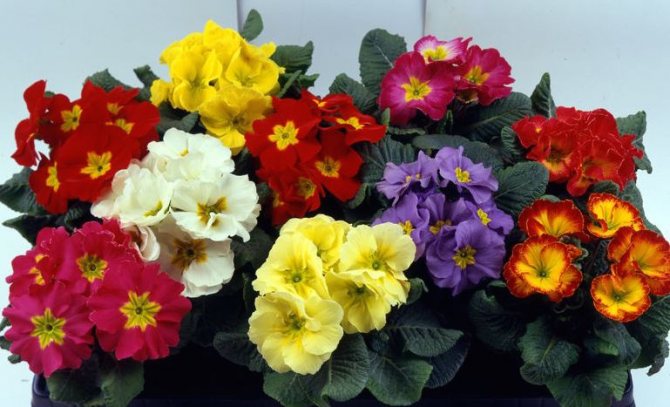

Primula Mix
When choosing an area for placement, it is important to take into account that the Mix primrose, like other varieties, needs an area that is not exposed to direct sunlight. Lighting should be as diffuse as possible. Watering the flower in a new pot is necessary when the soil dries out. Top dressing is best done after at least 1.5, maximum 2 weeks, applying fertilizers regularly.
Tip: If you want good results for primrose care at home, choose a flowering version that does not have gray mold (even in the area of undeveloped buds, under leaves, etc.). Also, the flower should not have dried out areas.
What does a plant look like in nature
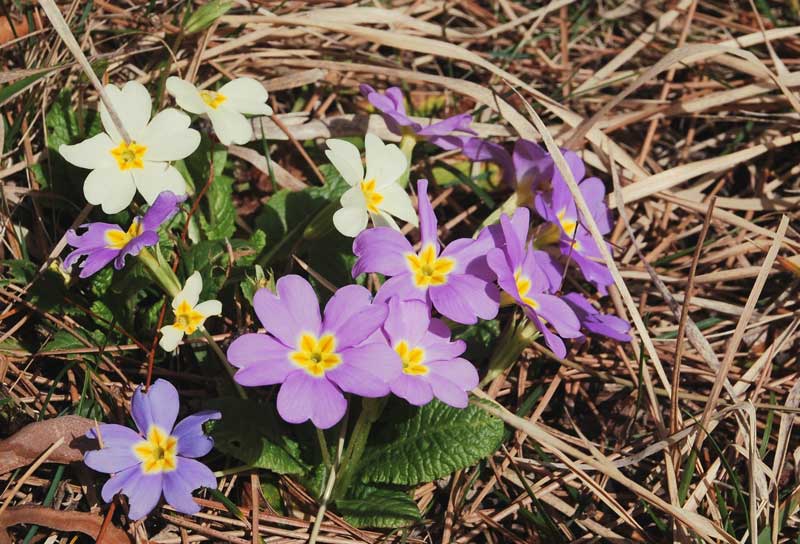

Under natural conditions, primrose grows near mountain streams, streams and in meadows. The plant is very compact and reaches a height of no more than 50 cm. The branched primrose rhizome is located in the upper layers of the earth, and a leaf rosette with oval gray-green leaves forms immediately above its surface. Flowers are monochromatic and variegated. After pollination by insects, the plant ripens capsules containing elongated seeds.
Even a beginner can grow room primrose. But you should not buy it for people prone to allergic reactions, since this plant can cause irritation. It is also necessary to protect pets and young children from contact with the poisonous leaves of the plant to prevent them from developing dermatitis.
Plant diseases
Primroses have strong immunity. Failure to comply with agrotechnical recommendations leads to the appearance of diseases in room primrose. With abundant moisture, rot appears on various parts of the plant. Fungal infection is manifested by the appearance of brown spots and plaque. The buds dry and fall off. The flower is treated with fungicides. Affected leaves are destroyed. Common diseases include:
- spotting;
- root rot;
- powdery mildew.
Indoor primroses rarely infect insect pests. One of the few enemies of the flower is the spider mite.
More details about choosing a pot


A pot for planting a flower at home should have a relatively shallow depth, while being quite wide. The plant is endowed with a fibrous, rather voluminous rhizome system, and needs a sufficient amount of free space.
The container intended for Mix primrose, or other types, must be made of any material other than metal and glass. These textures are cold. They are able to quickly cool down and cool the root system of the plant.
Flower pruning
Caring for primrose is not only watering and feeding, the plant must be pruned in time. Not everyone knows which leaves should be removed and whether primrose should be trimmed at all after flowering.
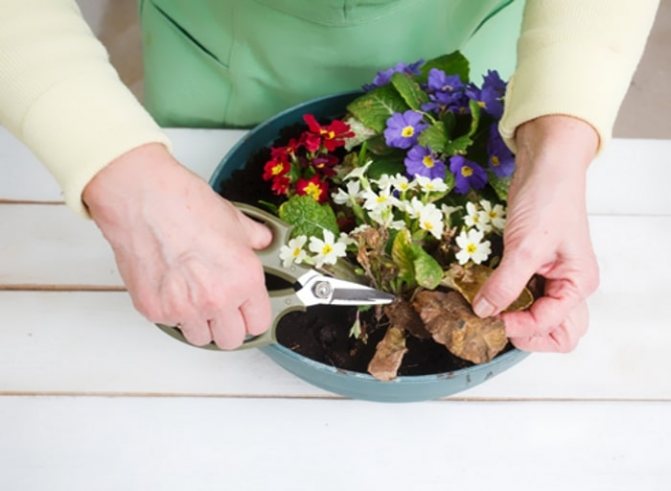

Pruning dry leaves
For indoor primrose, it is necessary to carry out sanitary pruning during flowering and when it fades. In the summer, you need to cut off the dry leaves of the primrose so that they do not interfere. It is impossible to cut the foliage of garden varieties before winter, since it protects the flower from hypothermia. Indoor plants spend the winter indoors, regardless of the season, yellowed leaves must be cut off from the indoor flower.
During the flowering period, the primrose needs sanitary pruning, at this time the wilted flowers must be removed along with the peduncle stem. If this is not done, they will draw some of the nutrients from the soil. After removal, all the forces of the plant will be directed to the formation of new inflorescences.
The real decoration of any garden or apartment is a blooming primrose, the timing of its flowering depends on how it was looked after and under what conditions it grows. If the plant is provided with the necessary conditions, it will delight with lush flowering for several months in a row.
Landing


After buying a room primrose at a flower shop, you need to transplant it into a suitable pot. It is advisable to purchase a small container with drainage holes. The soil mixture can be prepared independently by mixing peat, steamed sand and leafy soil in equal parts. When growing inverse conical primrose in the soil, it is advisable to add 1 part of turf.
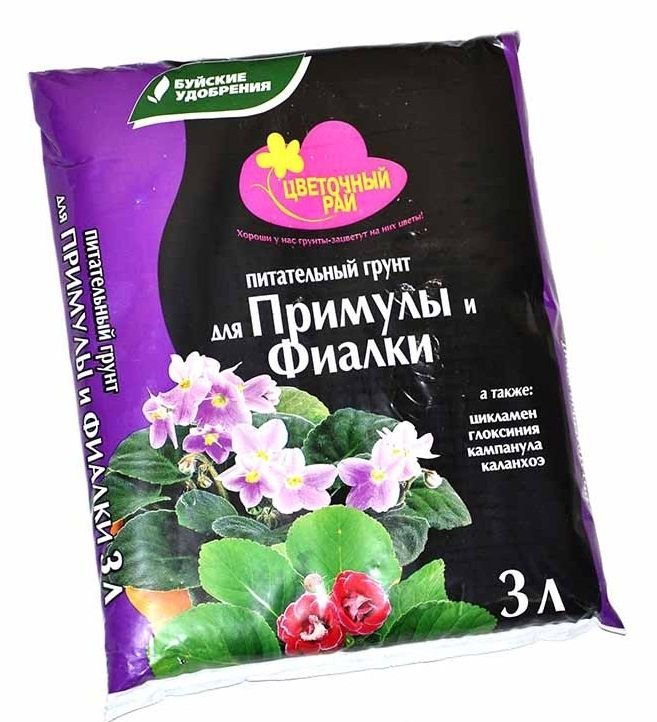

Ready-made soil mixture can also be purchased at a flower shop. For growing this plant, a nutritious soil is suitable, intended for primroses and violets. Before pouring the soil into the selected pot, a drainage layer should be laid on the bottom of the container.
Bloom
When and how it blooms
It is believed that primroses bloom only in early spring. Primrose is a plant whose flowering time depends on the variety.Some species bloom from April to June, while others bloom in early summer.
When hydrangea blooms - flowering period, how long does it bloom
With a relatively small plant size, large and bright flowers grow on it. Often, the inflorescences are in the shape of an umbrella, grow on a flowering stem from 25 to 50 cm in height. Depending on the variety, 1 flower or a group of several buds grows on the stem.
The color range is extensive, includes shades of purple, red, flowers can be white, yellow or pink. Petals are monochromatic or variegated in 2 or 3 colors at once.
Perennial varieties that bloom every year are very popular. Houseplant lovers know how much perennial primrose blooms and appreciate it for it. When properly maintained, the flowering period can last during winter and spring.
Flowering period
One of the best indoor flowers that takes root quickly at home is primrose. How much does this plant bloom? On average, the flowering period lasts 1-3 months, during the year different types of primrose bloom several times.
If the indoor primrose has faded, what to do next:
- Remove dry and yellow leaves, inflorescences;
- Reduce watering to 1-2 times a week with small portions of water. It is not necessary to spray with water from a spray bottle;
- Leave the plant in a cool, lit room.
Why does not it bloom
Primroses look great during flowering, that's why they are bought. Sometimes primrose owners are faced with the problem of the absence of flowers on the plant, the reasons for this may be different:
- Increased room temperature. Primroses do not tolerate temperatures above 19-20 ° C, they will grow, but without flowers;
- Low humidity in the room, in this case, the flower begins to dry, it does not have enough strength to bloom. Also, do not expose primrose to direct sunlight;
- Strong drafts. Indoor plants are less resistant to temperature extremes;
- Lack of sunlight. This usually happens if the pot is near the north window;
- During the heating season, a pot with a flower stands on the windowsill above the radiator;
- Lack of space in the pot. Over time, the flower grows, it needs to be transplanted - the previous volumes of land may not be enough for it. The new pot should be 2-3 times the size of the top of the plant;
- Lack of fertilizers. If the soil did not have time to feed, the primrose may not have enough nutrients to form inflorescences;
- Too frequent watering, use of untreated tap water;
- Incorrect soil composition and soil salinity;
- Lack of a drainage layer at the bottom of the pot, stagnant water;
- The plant is affected by diseases or pests. You can recognize the problem by the color of the leaves, they change their color or become stained;
- Too early to bloom. Perhaps a primrose grows at home, the flowering season of which begins later.
Having at least 1 problem can slow down the flowering period. If all the reasons are eliminated, the plant will bloom again next season.
Note! Annual plants are often sold in flower shops, this should be specified when buying. If the primrose is annual, there will be no re-flowering.
Winter storage and transplanting
If you become the happy owner of an indoor primrose in the snowy season, then in order to preserve it, a primrose transplant is imperative - it will not live long in a store substrate made of peat and a small amount of fertilizer.
The procedure should be carried out one day after the purchase of the green beauty.
- Find a convenient pot, add drainage to the bottom, prepare a versatile substrate and a small amount of river sand.
- Carefully remove the plant itself from the old container, being careful not to damage the rhizome.
- Mix the earth with river sand and sprinkle the drainage with a little mixture.
- Next, hold the rosette of the plant with one hand, and with the other, gently pour in the substrate to the edges of the pot.
- Sprinkle the primrose liberally with soft, settled water. Now she will be able to bloom and delight the owners all winter.
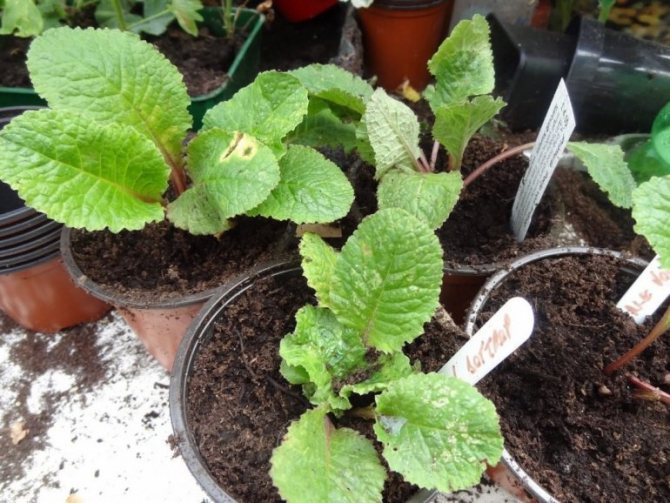

If the primrose transplant was done in advance, then make sure that it stands in a warm room in winter, avoid drafts. Low temperatures are detrimental to room culture, so it is recommended to choose a place on the windowsill, not too close to the battery, where diffused sunlight will fall.
What to do if a room primrose is affected by gray mold
You see that your plant is sick with gray mold and immediately think about why this happened. The cause of this disease can be improper watering, if, when watering primrose, water gets on the leaves, also the reason is high air humidity.
As a result, a gray bloom of sporangia appears on the primrose leaves. Primroses usually get sick with this disease in spring and autumn, when warm, damp weather sets in after frosts. To prevent this from happening, the soil must dry out between waterings. With this disease, old leaves are removed. From chemicals used drugs Fitosporin-M, Alirin-B, Gamair.


What to do if the leaves of the room primrose began to turn yellow
If your primrose has started leaves, then first you need to determine the cause of the yellowing of the leaves. The reason for the yellowing of the leaves of primrose may be too high an air temperature or dry indoor air. Also, primrose leaves can turn yellow due to abundant watering of the flower or an excess of fertilizers.


Subtleties of care
The attitude of flower growers to the nature of this beauty is ambiguous - some consider her capricious, others unpretentious, and each of them is right in his own way. Growing obkoniki will seem difficult for a novice florist, but for an experienced florist with an impressive baggage of knowledge and experience, it will not be difficult. In general, the obkonika agrotechnology is simple. Here are the basic elements of caring for room primrose obkonik at home.
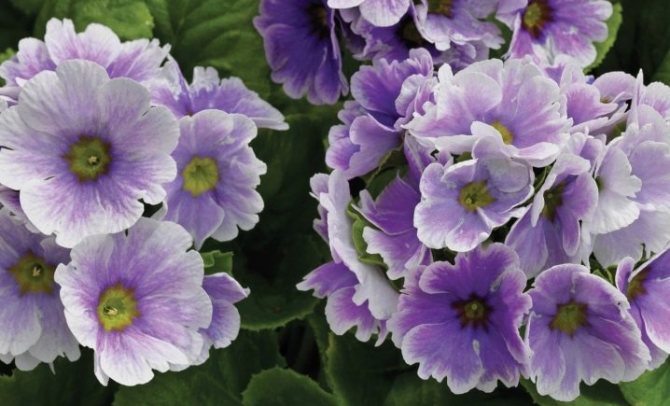

Illumination
Obkonika prefers well-lit, but not sunny places. It will be best to place the primrose pot on the southeast or southwest windowsill. Alternatively, you can put a flower on the north window, but when cloudy weather sets in for a long time, you will need a fluorescent lamp for additional illumination.
If all the windows in the apartment face south, and you really want to grow a primrose, then you can place it not on the windowsill, but a little further away on a flower stand.


Thermal regime
The comfortable temperature for the obkonika should not be higher than 20 degrees, and during the budding and flowering period it drops to +15 degrees to extend the timing and increase the flowering intensity. In modern conditions, portable floor air conditioners will help to create such parameters of the thermal regime. For the summer, primrose can be dug in the garden along with a pot in a semi-shaded place, where rainwater will only benefit her, over the summer the bushes will become stocky and curly. In the fall, it is important not to miss the moment when the primrose needs to be returned to the house, since the temperature below +5 degrees is unacceptable for these plants. For successful wintering, experts consider the optimal room temperature to be +12 +15 degrees.


Watering
Primrose does not like either waterlogging or overdrying, but it will tolerate a short-term lack of moisture without consequences. If you made a mistake and missed the timely watering, but caught on in time and corrected the situation, then the flower will not be particularly "offended" and will quickly restore its decorative effect. The main thing is that such care mistakes do not become systematic. Water for irrigation should be used that has settled during the day. You need to water directly at the root (not on the leaves).
It is not necessary to allow stagnation of water in the pan, but drain the excess 7-10 minutes after watering in order to avoid rotting of the root system.
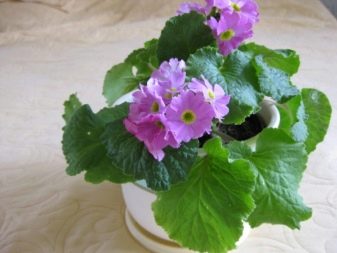

Groups of varieties and hybrids
The Dutch breeders "saved" the situation. The modern obkonika primrose hybrids created by them practically do not emit primin and are not allergens, which allows, if desired, to grow these delicate touching plants for all lovers of indoor flora without fear.
- Large-flowered variety of primroses Touch me has graceful bushes with large flowers of various colors, which are most decorative in spring and autumn during the peak flowering period. This primrose is completely safe from a medical point of view.
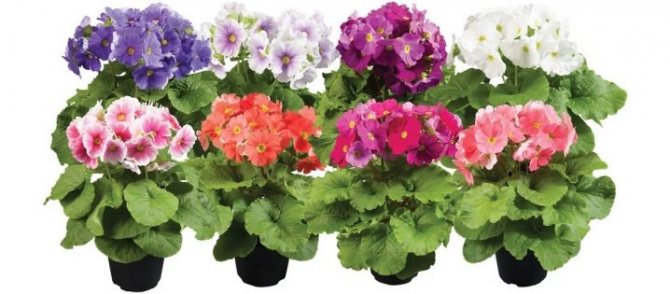

- Grades of the Grace F1 series characterized by compact plants (20-25 cm high) with large flowers, shining with a bright palette of various colors and shades.
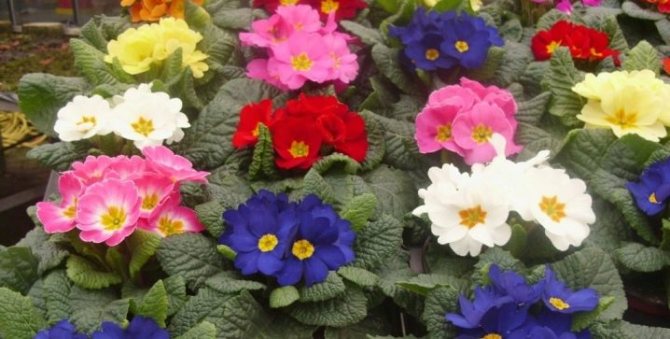

- Libre F1 Series in green parts of plants does not contain the allergen primin. The color of the flowers in this series contains 9 shades, among which orange and two-tone corollas look unusual. The leaves are collected in a root rosette. One plant can throw up to 10 peduncles, each can form up to 20 flowers.

